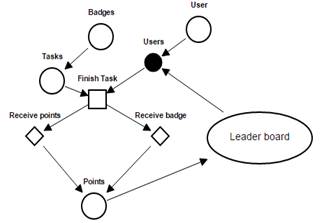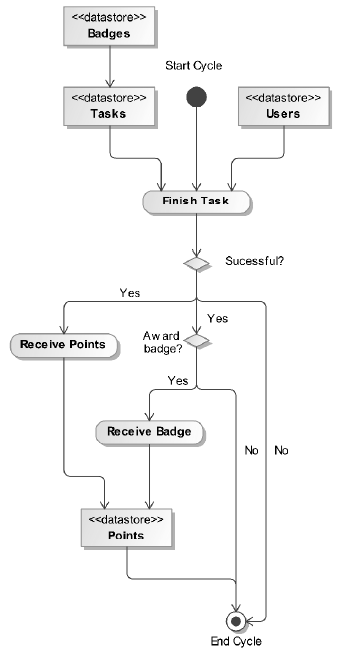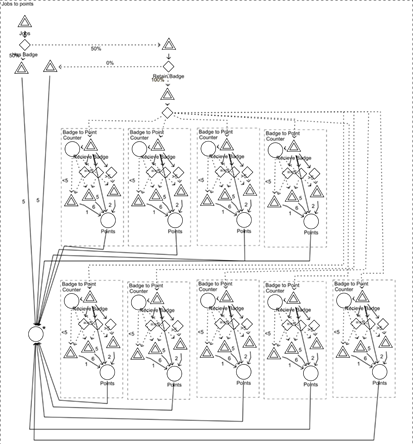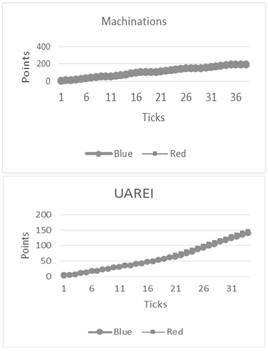UAREI: A model for formal description and visual representation /software gamification
UAREI: Un modelo para la descripción formal y la representación visual de la gamificación de software
DOI:
https://doi.org/10.15446/dyna.v84n200.54017Palabras clave:
gamification, modelling, abstraction, formal model (en)gamificacion, modelado, abstracción, modelo formal (es)
Descargas
Recibido: 7 de noviembre de 2015; Revisión recibida: 12 de octubre de 2016; Aceptado: 17 de diciembre de 2016
Abstract
The paper presents the UAREI (User-Action-Rule-Entities-Interface) model for formal specification of software gamification, and the UAREI visual modelling language for graphical representation of game mechanics. A case of study in gamification of the Trogon project management system is presented. The proposed model and visual language is compared against the Machinations gamification framework using visual complexity metrics, game simulation and qualitative comparison.
Keywords :
gamification, modelling, abstraction, formal model.Resumen
El artículo presenta el modelo UAREI (Usuario-Acción-Regla-Entidades-Interface) para la especificación formal de gamificacion software y el UAREI visual lenguaje de modelado para la representación gráfica de la mecánica del juego. Un estudio de caso en gamificacion del sistema de gestión de proyectos Trogon se presenta. El modelo y visual lenguaje propuesto se compara con las maquinaciones marco gamificacion utilizando métricas de complejidad visuales, juego de simulación y comparación cualitativa.
Palabras clave :
gamificacion, modelado, abstracción, modelo formal.1. Introduction
Gamification have been defined as a process which shapes the world (achieves goals/objectives) by influencing the actions, behaviours, characteristics and state of entities within the world through the use of games strategies and enabling technologies [1]. The concept is relatively new, but it has gained considerable interest in the software development and user interface design community over the last few years. The roots of gamification are in game design, with some elements from psychology, so there are still little academic research how to design and develop software systems with and for gamification.
According to Gartner Inc. [2], the widespread interest that gamification has been attracting recently lies in its potential to strengthen engagement, change user behaviours and support innovation. Game theory based models are being widely adopted now in different contexts and used as a driver for solving problems in a wide variety of domains, including disaster management [3], education [4,5], e-learning [6], workplace improvement [7], marketing [8], healthcare management [1,9], IT service management [10], social policy [11], sports and fitness [12], tourism business [13], customer engagement, social missions, fostering creativity, employee and management training, etc.
The underlying concept of gamification is motivation. Gamification is driven primarily by the external motivation, i.e., the users strive to compete against other playing users and to get recognized by the game community [12]. As motivation tends to decay over time, it however must be supported by the increasing complexity and evolving dynamics of game mechanics [14]. Meaningful gamification (otherwise known as “serious game”) is the use of game design elements to help users find meaning in a non-game context. Rather than just using game mechanics to give points or badges to users as external rewards, meaningful gamification focuses on the playing process (aka game mechanics) itself in order to engage the players to do meaningful tasks in a real world.
The modelling of gamification is important for design of systems based on the principles of serious game in order to quantify and validate the impact of gamification and to get a better understanding why and how gamification works. Existing evaluations of gamification usually focus on using user questionnaires and other methods of qualitative evaluation. There is still lack of high-level formal or abstract modelling methods and tools to aid the design and development of gamification in serious systems.
This paper aims to introduce tools which would allow to build a bridge between formal modelling of gamification and quantitative simulation of games, analysis and evaluation of game rules and processes.
The structure of the remaining parts of the paper is as follows. The overview of gamification models and gamification modelling languages is presented in Section 2. Similar formal approaches to game design are considered in Section 3. Formal description of the proposed UAREI (User-Action-Rule-Entities-Interface) model is given in Section 4. The visual notation used for modelling is described in Section 5. A case of study is presented in Section 6. The evaluation is given in Section 7. Finally, the conclusions are presented in Section 8.
2. Gamification models and modelling languages
In game research there is a strong separation between design methodologies and usability evaluation tools, which are rarely employed in the early stages of the design process. Although the game developers use many often heuristically designed tools to assist the design, there is still very little existing methods employed to connect design practices with gamification and game design [32]. Currently game and gamification development is strongly related to the qualifications and skills of game designers. This limitation drives the need to better and faster game building. Recently several new tools were developed or adapted to help game designers to model, build and analyses games.
Unified Modelling Language (UML) is a de-facto standard modelling language used in multiple domains. Tenzer [15] argues that UML modelling tools could be also used to build games and proposes a framework for building games using UML. The advantage of UML is that it is well known in the software engineering community. SysML is a general-purpose modeling language for systems engineering applications. That supports specification, analysis, design and verification of a broad range of systems. SysML has been used for building a training game [16].
The most notable examples of domain-specific game description languages are GaML [17,18] and ATTAC-L [19]. GaML is a formalized language for specifying and automatically generating gamification solutions. This allows to free the IT expert from the generation of gamification solutions. ATTAC-L is a domain specific language which allows the user to specify the game scenario in XML and to build a game using a code generator.
Another approach to gamification modelling is based on using formal (or mathematical) models [20]. Kim and Lee [21] model the effectiveness of gamification effectiveness using a mathematical model based on a sigmoidal equation. They argue what gamification effectiveness can be represented using curiosity, challenge, fantasy and control factors. Bista et al. [22] have proposed the first formal gamification model. Chan et al. [23] offer a similar approach for social game modelling, which also allows for verification of the built model. Oliveira et al. [24] model games using Petri nets. The disadvantage of this approach is the lack of domain specificity which is preventing its adoption by game designers.
The third category of gamification modelling approaches is visual languages for fast prototyping in gamification domain. Most known examples are Sketch-It-Up [25], Ludocore [26], and Machinations [27]. Sketch-It-Up is a tool for creating sketches of possible games. Ludocore is a logical “game engine”, which employs formal logic used by automated reasoning tools in AI domain to enable automated design and prototyping of game systems and providing fast feedback to the designer. Machinations is a conceptual framework and diagram tool that focusses on structural qualities of game mechanics. Machinations graphical diagrams are an abstraction of Petri nets for modelling and simulating games and game-like systems on a varying level of abstraction. Recently, Micro-Machinations [28] were proposed for reusing Machinations models in software development.
3. Formal models of game design and gamification
Games are a kind of systems and the design of games is the creation of models for games [33]. In computer science, games can be considered as a kind of information systems consisting modelled using of objects (or entities, concepts), attributes (properties), their relationships and the environment (or context) [37]. A similar approach has been adopted by ontology engineering [34] for building ontologies, i.e., formal representations of concepts within a domain and the relationships between those concepts.
Formally, games can be modelled as abstract control systems [35] consisting of a set of states and a definition of the evolution of the state of game under different actions of a player. The game can be represented by a set of states, for which transition functions define when to move from one state to another. Following this approach, gamification can be described as the product of two games, where a gamified system is considered as one game with its one rules and mechanics, and the gamification layer is considered as another game.
Another game modelling framework presented in [36] incorporates structural, temporal and boundary frameworks (subsystems). The structural subsystem consists of Game Elements, Game Time, Players, Interface and the Facilitator, the arbitrating entity between the players and the game system, which takes care of setting up the game, synchronises the game state and maintains the game time. The temporal subsystem represents the flow and causality of the game by defining the actions that are provided and the actions that can be taken at the particular states in the game. The boundary subsystem defines the constraints in the game that limit the activities performed in a game by establishing social contracts between the players which have to be satisfied while playing through a set of limitations.
In [38], another kind of formal model (Petri Nets and Hypergraphs) are investigated and methods and tools for the integration of formal modelling into the game design and production process are proposed.
These efforts in formal game modelling are however directed at game design rather than gamification of the existing systems as considered in this paper. In the following Section, the elements of the proposed UAREI model are presented.
4. Description of gamified systems as UAREI model
The gamified systems can be described as a tuple G ={U,A,R,E,I} , here: U - users, which are interacting with the system; A - actions, which trigger system behaviour; R - rules, which encapsulate logic in the system; E - data entities; and I - interfaces which define data format.
The users are defined as a tuple U ={ LU,SU }, here: LU - a set of all outgoing links to other elements in the model; and SU - a selection function which defines how a user is selected from a collection in a simulation mode.
Actions are a collection A ={ A1, A2, …, Ai, …, An }, here Ai is a single action, n the total number of actions. A single action is defined as Ai ={ LA,SA }, here: LA - a set of all outgoing links to other elements in the model, and SA - a selection function, which defines the way an action related data entity is selected from a collection.
Rules are a collection R ={ R1,R2 , …, Ri , …, Rn }, here Ri is a single rule, n the total number of rules. A single rule is defined as Ri = { LR,Ri (C,M)}, here: LR - a set of all outgoing links to other elements in the model, and ri (C,M) is a rule function defined as:

here: C - context of current execution path; M - a system model; y is a computed result value, and NULL is returned if rule doesn’t apply.
Rules are used to control context flow in the system. If a rule execution evaluates to an empty result the current execution path is continued. We can define the “else” path by using inversion “! Ri ”. No data will be stored in storage and no other rules will execute if the previous rule failed or returned empty value, but system flow will continue giving feedback to the user node. Rules can update the context in anyway needed for the application.
Entity collection is a collection of all data entities in the system  , here Ei is a single storage entity and n is the total number of storage entities. A single entity is defined as
, here Ei is a single storage entity and n is the total number of storage entities. A single entity is defined as  here: D- entity scheme definition, O - data objects, and L
E
- a set of all outgoing links to other elements in the model.
here: D- entity scheme definition, O - data objects, and L
E
- a set of all outgoing links to other elements in the model.
Interface is a collection  , here Ii is a single interface and n is the total number of interfaces. A single interface is defined as Ii = {LI, Q}, here: LI -a set of all outgoing links to other elements in the model, Q - data query, on which the data for the interface is selected.
, here Ii is a single interface and n is the total number of interfaces. A single interface is defined as Ii = {LI, Q}, here: LI -a set of all outgoing links to other elements in the model, Q - data query, on which the data for the interface is selected.
Source: The authorsTable 1: Graphical notation of UAREI modelling language
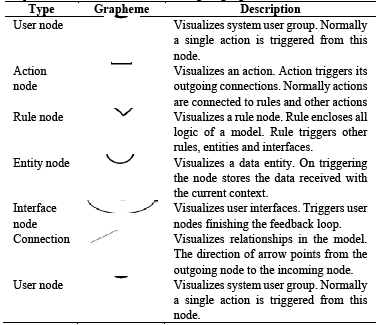
5. Graphical notation of UAREI model
The UAREI model is visualized as a directed graph consisting of nodes (vertices) and links (edges) between nodes as follows: G ={L,N}, here: N is a set all nodes N =  ; is a set of links between nodes
; is a set of links between nodes  , and
, and  are collections of corresponding types of nodes
are collections of corresponding types of nodes  , Li is the list of links, Li = (Nout; Nin), here,
, Li is the list of links, Li = (Nout; Nin), here,  - are links which start N
i
node.
- are links which start N
i
node.
In Table 1 we present the list of graphical symbols (graphemes) used in the UAREI model diagrams.
6. A case of study in modelling gamification in Trogon PMS
For the illustration of gamification modelling, we have selected the Trogon Project Management System (PMS) already discussed in our previous work [29,30]. Here we demonstrate how gamification rules can be described and modelled using the proposed UAREI model as well as depicted graphically using the proposed graphical notation. The gamification solution for Trogon PMS is defined as follows:
A software company employee receives random stream of tasks is coming from the project manager. There are two main types of tasks - normal tasks and tasks with badges. There are nine distinct types badges rewarded based on the tickets specificity. Everything translates to points, a certain amount of points is awarded per task done. Based on the number of badges of the same type a bonus is awarded. For every task completed with a badge a user gets 20% bonus. When five and more of the same type badges are collected for those tasks the user is awarded with an additional 20% bonus. There is a quality element to the tasks done, if the task fails to pass Quality Assurance, a badge can be removed.
The Trogon PMS gamification is defined using the UAREI model as follows:

here:
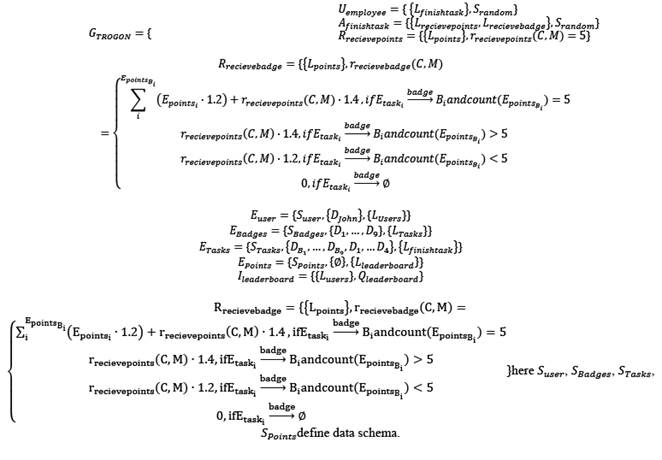
In order to be made executable, a formal model has been converted into a JSON notation. This is done by writing down a JSON structure, which is composed of two parts (model nodes and model name). Every model node follows main format of name, type and links. Rules are generated by interpreting a meta-language represented as a JSON structure. The language has 1 to 1 translatable language constructions like conditions, iterations, logical operations, mathematical operations and other. Next to this the meta-language has code structural constructs. The language can be extended with necessary element to support required features.
The model of gamification of Trogon PMS using the UAREI modelling language is given in Fig. 1. The model contains:
Entities: E user - all system employee, E Badges - types of badges, E Tasks - the tasks which can be completed by employees, E Points - points gained by the users.
Users (U employee ) node which is a starting point for interaction with the system.
System has only a single action (A finish task ) which is triggered by system users when a task is completed.
Figure 1: Visual model of Trogon PMS gamification.
System has two main rules: the Points rule (R recieve badge ) describes normal behavior how user receives the points for a completed task, and the Badge rule (R recieve badg ) describes how user gets points for finished tasks which have badges associated with them.
For comparison, the UML diagram which represents the same logical flow is given (see Fig. 2) as well as the same model described using the Machinations visual notation (Fig. 3).
User feedback loop is finished by leader board interface (I leaderboard ), which gives relevant feedback to the user.
As the UAREI model is described using the elements of the graph theory, we use the graph metrics to evaluate its visual complexity: number of nodes N, number of links E, and McCabe Cyclomatic Complexity defined as
M=E-N+2∙P,
here P is the number of independent paths in a graph.
The complexity of the UAREI and Machinations gamification models of Trogon PMS is summarized in Table 2. The comparison results show that the UAREI model is significantly less complex than its Machinations counterpart.
Figure 2: Gamification model of Trogon PMS specified using UML activity diagram.
Source: created by the authorsTable 2: Visual complexity of Trogon PMS models.

The computational simulation results of the proposed gamification model are presented in Fig. 4. The UML activity model is not illustrated, because UML has no simulation engine.
We assume that the system has two players (‘Blue’ and ‘Red’) with exactly the same behaviour competing at the same time. Fig. 4 shows the data recorded during such simulation.
There are two distinct parts of the simulation:
-
Tie zone - from the start models are behaving similarly and both players have a similar number of points.
-
Winner zone - one of the players starts winning and the other player needs time to close the gap.
-
Both players can become the winner because:
-
At the core of these models is a binomial distribution of a fare coin, so any player can win based on luck, while no player specific attributes are taken into consideration.
-
The winner is only determined, because we stop the model at a certain time limit. In case the model goes to infinity we would end up in a tie state.
-
There is some difference in the simulation data, because of different simulation execution and model specifics. In case of Machinations, a tick is executed every time the resource passes from node to node, and in the UAREI model a data record in point entity triggers a data point in the graph.
7. Evaluation
For comparative evaluation, we use the Machinations visual language [27]. As comparison criteria we use the most important problems / attributes in gamification modelling.
The game rules are supported in both UAREI and Machinations. The main difference is that Machinations only allow to build a logical structure to imitate the “rule” concept. UAREI natively supports the rule concept. Rule in the model holds the logic inside it and not disclosing its logic in model visualization. This is a main difference between these two modelling tools. The biggest problem in Machinations is that model complexity grows exponentially if one tries to model real world systems. In UAREI, most of the game logic is encapsulated in rules which decreases model complexity.
Both modelling frameworks support user-based modelling. However, in Machinations every user behaviour model has a separate copy of the model. UAREI natively supports multiple users working with the same model in parallel. Machinations currently support logical attributes which describe user behaviour. UARSEI currently does not have such modelling capacities.
Figure 3: Gamification model of Trogon PMS specified using Machinations.
Figure 4: Simulation of game results using Machinations and UAREI.
Machinations is based on the economic functions and the resource concept. UAREI natively focuses on real data entities which carry more information. UAREI has the “context” concept which is carried through the model execution flow. In general, the context concept of UAREI is similar to Machinations resource concept.
UAREI supports real world data entities and that allows mapping into software domain. UAREI separates actual data from the actual model. Normally in software engineering this is a common way to ensure data-program separation, the same concept is encapsulated into UAREI. Machinations does not have a concept of data.
Machinations does not have any model transformation capabilities and it never was designed for this goal. On the other hand, UAREI is designed for transformation into executable code. The rule logic is written in a meta-language which is processed into executable Javascript code. Other model parts are executed using a simulator.
Both UAREI and Machinations have minimal analysis tools which allow to view model data. In Machinations one is able to view “pool” changes over time. In UAREI one is able to see interface data change over time.
UAREI has a native feedback loop in the system. The modelling framework is designed to ensure feedback to model users. In Machinations it is up to designer to setup such loop to model user behaviour during simulation.
Source: created by the authorsTable 3: Graphical notation of UAREI modelling language

Source: created by the authorsTable 4: Cognitive dimensions of UAREI and Machinations.

8. Conclusions
In this paper we have presented the description of the UAREI modelling framework. We have demonstrated a case of study in modelling the Trogon PMS gamified application using UAREI. The same gamified application was modelled using the Machinations framework and UML activity diagrams. All modelling frameworks are good tools for modelling gamification of software systems.
All analysed models were used to compare their visual complexity. We run a sample simulation of two players using the system under UAREI and Machinations. The comparison disclosed the benefits and weakness of the modelling frameworks in question as follows.
The advantages of the UAREI model are a high level of abstraction, native support for feedback, model transformation to executable code, explicit separation of data and code. The disadvantage of the UAREI model is that currently it still does not support reusability.
Future work will focus on improving properties of the UAREI model in supporting model transformation, analysis and reusability.
References
Referencias
Wortley, D., Gamification and geospatial health management, Proc. of 7th IGRSM International Remote Sensing & GIS Conference and Exhibition IOP Publishing. IOP Conf. Series: Earth and Environmental Science, 20, 2014. DOI: 10.1088/1755-1315/20/1/012039
Gartner Group, Gartner Says By 2015, More Than 50 Percent of Organizations That Manage Innovation Processes Will Gamify Those Processes. 2011.
Vasquez, O.C., Sepulveda, J.M., Alfaro, M.D. and Osorio-Valenzuela, L., Disaster response project scheduling problem: A resolution method based on a game-theoretical model, International Journal of Computers Communications & Control, 8(2), pp. 334-345, 2013. DOI: 10.15837/ijccc.2013.2.313
Caponetto, I., Earp, J. and Ott, M., Gamification and education: A literature review, Proc. of the 8th European conference on games ECGBL 2014, pp. 50-57, 2014.
Bothsa, A., Herselman, M. and Ford, M., Gamification beyond badges, IST-Africa Conference Proceedings, IEEE, pp. 1-10. 2014.
Gené, O.B., Martínez, M. and Blanco, F., Gamification in MOOC: challenges, opportunities and proposals for advancing MOOC model, Proc. of the 2nd Int. Conference on Technological Ecosystems for Enhancing Multiculturality, 2014, pp. 215-220. DOI: 10.1145/2669711.2669902
Sammut, R., Seychell, D. and Attard, N., Gamification of project management within a corporate environment: An exploratory study. Proc. of 6th International Conference on Games and Virtual Worlds for Serious Applications (VS-GAMES), pp. 1-2. IEEE, 2014. DOI: 10.1109/vs-games.2014.7012158
Freudmann, E.A. and Bakamitsos, Y., The role of gamification in non-profit marketing: An information processing account, Procedia - Social and Behavioral Sciences, 148, pp. 567-572, 2014. DOI: 10.1016/j.sbspro.2014.07.081
Wilson, A.S. and McDonagh, J.E., A gamification model to encourage positive healthcare behaviours in young people with long term conditions, EAI Endorsed Trans. Serious Games 2: e3, 2014. DOI: 10.4108/sg.1.2.e3
da Conceicao, F.S., da Silva, A.P., de Oliveira-Filho, A.Q. and Silva-Filho, R.C., Toward a gamification model to improve IT service management quality on service desk, Proc. of 9th International Conference on the Quality of Information and Communications Technology (QUATIC), IEEE, pp. 255-260. 2014. DOI: 10.1109/quatic.2014.41
Hall, M., Kimbrough, S.O., Haas, C., Weinhardt, C. and Caton, S., Towards the gamification of well-being measures, IEEE 8th International Conference on E-Science (e-Science), 2012, pp. 1-8.
Larsson, R.S., Motivations in sports and fitness gamification: A study to understand what motivates the users of sports and fitness gamification services, MSc Thesis, Umea Universitet, Umeå, Suecia, 2013.
Wells, S., Kotkanen, H., Schlafli, M., Gabrielli, S., Masthoff, J., Jylhä, A. and Forbes, P., Towards an applied gamification model for tracking, Managing, & Encouraging Sustainable Travel Behaviours. ICST Trans. Ambient Systems 4: e2, 2014. DOI: 10.4108/amsys.1.4.e2
Bauckhage, C., Kersting, K., Sifa, R., Thurau, C., Drachen, A. and Canossa, A., How players lose interest in playing a game: An empirical study based on distributions of total playing times. IEEE Conference on Computational Intelligence and Games (CIG), 2012, pp. 139-146. DOI: 10.1109/CIG.2012.6374148
Tenzer, J., Improving UML design tools by formal games, Proc. of 26th Int. Conference on Software Engineering (ICSE 2004), IEEE, pp. 2004, 75-77. DOI: 10.1109/icse.2004.1317428
Hetherinton, D., SysML requirements for training game design, Proc. of IEEE 17th International Conference on Intelligent Transportation Systems (ITSC), 2014, pp.162-167. DOI: 10.1109/ITSC.2014.6957684
Herzig, P., Jugel, K., Momm, C., Ameling, M. and Schill, A., GaML-A modeling language for gamification, Proc. of IEEE/ACM 6th Int. Conference on Utility and Cloud Computing, 2013, pp. 494-499. DOI: 10.1109/ucc.2013.96
Matallaoui, A., Herzig, P. and Zarnekow, R., Model-Driven serious game development integration of the gamification modeling language GaML with unity, Proc. of 48th Hawaii International Conference on System Sciences (HICSS), IEEE, 2015, pp. 643-651. DOI: 10.1109/hicss.2015.84
Janssens, O., Samyny, K. and Hoecke, S., Educational virtual game scenario generation for serious games, Proc. of IEEE 3rd Int. Conference on Serious Games and Applications for Health (SeGAH), IEEE, 2014, pp. 1-8. DOI: 10.1109/segah.2014.7067106
Nummenmaa, T., Berki, E. and Mikkonen, T., Exploring games as formal models, In 4th South-East European Workshop on Formal Methods (SEEFM), IEEE, 2009, pp. 60-65. DOI: 10.1109/seefm.2009.15
Kim, J.T. and Lee, W.-H., Dynamical model and simulations for gamification of learning, International Journal of Multimedia and Ubiquitous Engineering, 8(4), pp. 179-190, 2013.
Bista, S.K., Nepal, S., Colineau, N. and Paris, C., Using gamification in an online community, CollaborateCom 2012, 2012, pp. 611-618.
Chan, K.T., King, I. and Yuen, M.-C., Mathematical modeling of social games, International Conference on Computational Science and Engineering, CSE'09, IEEE, 4, 2009, pp. 1205-1210. DOI: 10.1109/cse.2009.166
de Oliveira, G.W., Julia, S. and Soares-Passos, L.M., Game modeling using WorkFlow nets, in Proc. of IEEE International Conference on Systems, Man and Cybernetics (SMC), IEEE, 2011, pp. 838-843. DOI: 10.1109/icsmc.2011.6083757
Agustin, M., Chuang, G., Delgado, A., Ortega, A. Seaver, J. and Buchanan, J.W., Game sketching, Proc. of the 2nd int. conference on digital interactive media in entertainment and arts, 2007, pp. 36-43.
Smith, A.M., Nelson, M.J. and Mateas, M., Ludocore: A logical game engine for modeling videogames, in: IEEE Symposium on, Computational Intelligence and Games (CIG), 2010, pp. 91-98. DOI: 10.1109/itw.2010.5593368
Dormans, J., Machinations: elemental feedback patterns for game design, in: Saur, J. and Loper, M. (eds.), GAME-ON-NA 2009: 5th Int. North American Conference on Intelligent Games and Simulation, pp. 2009, 33-40.
van Rozen, R. and Dormans, J., Adapting game mechanics with micro-machinations, Proc. of the 9th Int. Conference on the Foundations of Digital Games, 2014.
Ašeriškis, D. and Damaševičius, R., Gamification patterns for gamification applications, Procedia Computer Science: 39, pp. 83-90, 2014. DOI: 10.1016/j.procs.2014.11.013
Ašeriškis, D. and Damaševičius, R., Gamification of a Project management system, Proc. of Int. Conference on Advances in Computer-Human Interactions ACHI2014, 2014, pp. 200-207.
Green, T.R.G. and Petre. M., Usability analysis of visual programming environments: A 'cognitive dimensions' framework, Journal of Visual Languages & Computing, 7(2), pp. 131-174, 1996. DOI: 10.1006/jvlc.1996.0009
Rao, V., Heuristic evaluation of persuasive game systems in a behavior change support systems perspective: Elements for discussion. Second International Workshop on Behavior Change Support Systems – BCSS, 2014, pp. 21-25.
Grünvogel, S.M., Formal models and game design, Game Studies 5(1), pp. 1-9, 2005.
Devedzić, V., Understanding ontological engineering, Communications of the ACM, 45(4), pp. 136-144, 2002. DOI: 10.1145/505248.506002
Tabuada, P., Pappas, G.J. and Lima, P., Compositional abstractions of hybrid systems. Discrete Event Dynamic Systems, 14(2), pp. 203-238, 2004. DOI: 10.1023/B:DISC.0000018571.14789.24
Narayanasamy, V., Wong, K.W., Rai, S. and Chiou, A., Complex game design modeling, Cultural Computing, Springer, 333, pp. 65-74, 2010. DOI: 10.1007/978-3-642-15214-6_7
Salen, K. and Zimmerman, E., Rules of play - game design fundamentals, The MIT Press, Cambridge, MA, USA, 2004.
Vega-Zazueta, L., Modélisation et analyse spatiale et temporelle des jeux vidéo basées sur les réseaux de Pétri, PhD Thesis, Paris, France, 2004.
Cómo citar
IEEE
ACM
ACS
APA
ABNT
Chicago
Harvard
MLA
Turabian
Vancouver
Descargar cita
CrossRef Cited-by
1. Ziyou Zhuang. (2021). Optimization of building model based on 5G virtual reality technology in computer vision software. Mathematical Biosciences and Engineering, 18(6), p.7936. https://doi.org/10.3934/mbe.2021393.
2. Zdravka Koleva, Donika Valcheva, Teodor Kalushkov, Georgi Shipkovenski, Petya Byalmarkova, Rositsa Radoeva. (2022). Personalised Approach For Building a Gamified Project For User Motivation Management. 2022 International Symposium on Multidisciplinary Studies and Innovative Technologies (ISMSIT). , p.934. https://doi.org/10.1109/ISMSIT56059.2022.9932743.
3. Jakub Swacha, Wiktor Przetacznik. (2024). In-Browser Implementation of a Gamification Rule Definition Language Interpreter. Information, 15(6), p.310. https://doi.org/10.3390/info15060310.
4. Jakub Swacha, José Carlos Paiva, José Paulo Leal, Ricardo Queirós, Raffaele Montella, Sokol Kosta. (2020). GEdIL—Gamified Education Interoperability Language. Information, 11(6), p.287. https://doi.org/10.3390/info11060287.
5. Ricardo Alexandre Peixoto de Queiros, Mário Pinto, Alberto Simões, Carlos Filipe Portela. (2022). Research Anthology on Game Design, Development, Usage, and Social Impact. , p.1. https://doi.org/10.4018/978-1-6684-7589-8.ch001.
6. Kendra M. L. Cooper. (2023). Software Engineering for Games in Serious Contexts. , p.1. https://doi.org/10.1007/978-3-031-33338-5_1.
7. Valentin Grimm, Jessica Rubart. (2021). Modelling Gamified Systems with Event Storming Augmented by Spatial Hypertext. Proceedings of the 4th Workshop on Human Factors in Hypertext. , p.3. https://doi.org/10.1145/3468143.3483927.
8. Jakub Swacha. (2018). Representation of Events and Rules in Gamification Systems. Procedia Computer Science, 126, p.2040. https://doi.org/10.1016/j.procs.2018.07.248.
9. Ricardo Alexandre Peixoto de Queiros, Mário Pinto, Alberto Simões, Carlos Filipe Portela. (2022). Next-Generation Applications and Implementations of Gamification Systems. Advances in Human and Social Aspects of Technology. , p.1. https://doi.org/10.4018/978-1-7998-8089-9.ch001.
Dimensions
PlumX
Visitas a la página del resumen del artículo
Descargas
Licencia
Derechos de autor 2017 DYNA

Esta obra está bajo una licencia internacional Creative Commons Atribución-NoComercial-SinDerivadas 4.0.
El autor o autores de un artículo aceptado para publicación en cualquiera de las revistas editadas por la facultad de Minas cederán la totalidad de los derechos patrimoniales a la Universidad Nacional de Colombia de manera gratuita, dentro de los cuáles se incluyen: el derecho a editar, publicar, reproducir y distribuir tanto en medios impresos como digitales, además de incluir en artículo en índices internacionales y/o bases de datos, de igual manera, se faculta a la editorial para utilizar las imágenes, tablas y/o cualquier material gráfico presentado en el artículo para el diseño de carátulas o posters de la misma revista.




